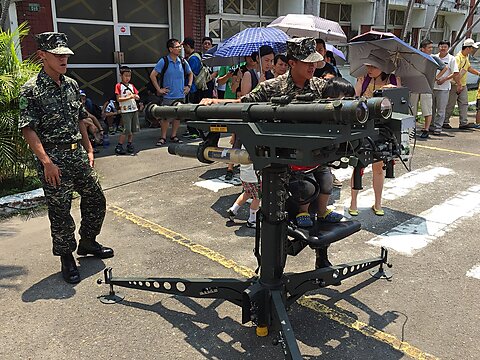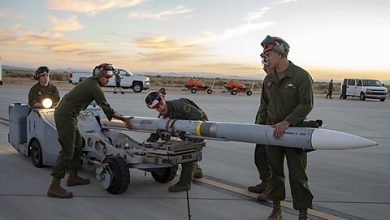Taiwan Arms Backlog, January 2024 Update: A Jump in Asymmetric Capabilities

Eric Gomez and Benjamin Giltner
In November 2023, we published the initial version of a dataset breaking down the backlog of US weapons that have been sold but not yet delivered to Taiwan. The dataset indicated that the overall size of the backlog was just shy of $19.2 billion, with traditional capabilities, such as F‑16 aircraft and Abrams tanks, making up the largest share by dollar value.
Based on interest in the original dataset, we have decided to update the Taiwan arms backlog dataset monthly, and release summaries explaining what, if anything, has changed within the backlog. We will also be updating our sources and methods as we locate new outlets of information and refine our methodology.
As noted in previous posts, the US arms backlog to Taiwan matters for three reasons. First, growing demands on the US defense industrial base will stress Washington’s ability to simultaneously arm itself and its friends, raising difficult questions of strategic prioritization. Second, sending weapons to Taiwan now, especially those that enable an asymmetric defense against invasion, should reduce the likelihood of US‐China conflict over Taiwan in the future. Finally, the Taiwan backlog is the impetus for ongoing policy debates on speeding up US arms sales that will have long lasting implications and could accelerate arms deliveries to bad actors.”
Between November 2023 and the end of January 2024, the US arms backlog to Taiwan decreased by approximately $140 million, remaining slightly above $19 billion. Figure 1 shows the January 2024 backlog broken down by type of capability. To compare the proportion of capabilities between January 2024 and November 2023, see Figure 2.
Every item removed from the backlog was a traditional capability, while every item added to it was an asymmetric capability. Of the three items removed from the backlog, two completed deliveries in 2023 and one was canceled. The three items added to the backlog are not new sales but were existing sales missing from the November 2023 version of the dataset. One of those items does not have information on the dollar value. This means the overall size of the backlog is likely higher than $19 billion.
Table 1 shows changes in the backlog by weapon system. Items removed since November 2023 are in red while items added are in green.
Sources and Methodology
Generally, data on arms sale announcements are much easier to find than data on weapons deliveries. The primary data source we use for arms sale announcements in the backlog dataset is the Defense Security Cooperation Agency (DSCA). Since November 2023, however, we noted at least one instance where the press reported an arms sale that was not included in DSCA’s list of major arms sales but was relayed to Congress.
To address this issue, we searched through every issue of the Congressional Record since January 2015 to locate instances of arms sales notified to Congress but not mentioned on the DSCA’s website. While nearly all announcements appear in both sources, we located one large arms sale that only appeared in the Congressional Record. Going forward, we will be using the Congressional Record to catch any major arms sales to Taiwan that are not reported by DSCA.
Our primary data source for weapon delivery timelines is the Stockholm International Peace Research Institute’s (SIPRI) arms transfer database, supplemented with press reporting. The SIPRI data are extensive. However, it is only updated once per year, and is somewhat out of date—the forthcoming spring 2024 SIPRI update will only cover deliveries to the end of 2023.
We will continue to supplement SIPRI’s data on weapons delivery with press reporting, with a focus on reports that cite Taiwan’s Ministry of National Defense (MND) as a source. The major new data source on weapon delivery timelines we are adding in this update is the MND’s archive of English‐language “Defense News” press releases, which occasionally provide information on delivery timelines.
Additions to the Backlog
There are three additions to the Taiwan arms backlog dataset. None of the additions are for new sales between November 2023 and January 2024. Instead, they were sales that were originally overlooked or excluded from the dataset.
First, in July 2019 the DSCA announced a sale of 250 man‐portable Stinger air‐defense missiles for $223 million. This sale did not appear in the November 2023 dataset because of press reports indicating delivery of Stingers from the 2019 sale. However, subsequent reporting from Taiwan in early 2024 indicated that only a first batch of Stingers arrived in 2023, with the rest expected to arrive later in 2024. Therefore, we have added this sale back to the dataset and will remove it once deliveries are complete. We code the Stingers as an asymmetric capability.
Second, the December 5, 2022 edition of the Congressional Record contains a notification of a sale of 100 Patriot Advanced Capability‑3 Missile Segment Enhancement (PAC‑3 MSE) interceptor missiles to Taiwan valued at $882 million. According to the notification, the sale is a modification to a January 2010 arms sale of Patriot batteries and missiles to Taiwan. The December 2022 PAC‑3 MSE sale was missing from the November 2023 dataset because it was not mentioned in DSCA’s archive of major arms sales. A January 2024 report from Taiwan News quotes the MND saying deliveries of the missiles will occur in batches between 2025 and 2026. We code the PAC‑3 MSE missiles as an asymmetric capability.
Third, on May 10, 2023, the MND announced that it would purchase 18 additional High Mobility Artillery Rocket System (HIMARS) launchers from the United States for an unspecified amount of money. These additional launchers come on top of an October 2020 DSCA announced sale of 11 launchers, for 29 total. The additional HIMARS were excluded from the November 2023 dataset because they were not included in the DSCA archive. Full delivery of the original 11 HIMARS is expected in 2025, with the 18 additional units arriving in 2026. HIMARS is coded as an asymmetric capability in the dataset. However, due to the lack of cost information, we do not know how much it impacts the backlog’s topline figure.
Reductions to the backlog
Three items were in the November 2023 backlog dataset that we have removed. Two arms sales completed delivery in 2023, and one arms sale was canceled.
In December 2015, the DSCA announced a sale of 13 Phalanx close‐in weapons systems to protect Taiwan’s surface warships against drones, missiles, and aircraft. According to an April 2023 press report, MND officials said that final delivery of the Phalanx guns would occur “before the end of the year [2023].” Delivery of the Phalanx systems reduces the overall size of the backlog by $416 million. We coded the Phalanx as a traditional capability because they are a subsystem of another traditional capability.
In June 2017, the DSCA announced a sale of upgraded electronic warfare systems for four Keelung-class destroyers. There is relatively little reporting on the delivery timeline of the electronic warfare systems compared to other US arms sales to Taiwan. The most recently available, credible report we located comes from late 2018 and gives a completion date of 2023, but does not specify a month. Delivery of the electronic warfare systems reduces the overall size of the backlog by $80 million. The electronic warfare system is coded as a traditional capability because it is a subsystem of another traditional capability.
The final removal from the arms backlog dataset is the cancellation of a $750 million order for Paladin self‐propelled howitzers, which the DSCA originally announced on August 4, 2021. In May 2022, the Washington Post reported that the howitzers were facing delays. Originally, we kept the Paladins in the November 2023 backlog because we could only find sources mentioning a delay of the program. However, we have since found more recent reporting citing Taiwan’s MND that confirmed the Paladin deal was canceled. The report links the expanded HIMARS buy to the decision to cancel the Paladins. We code the Paladin as a traditional capability.
Conclusion
Between November 2023 and January 2024, the backlog of US arms to Taiwan decreased slightly. However, it remains close to the $19 billion mark and is likely higher given the unknown price tag for additional HIMARS launchers. Two arms sales were completed by the end of 2023, but most of the changes in the dataset are driven by refining our sources and methods instead of new sales being announced or old sales being delivered.
The January 2024 update is good news for the balance of asymmetric and traditional capabilities that Taiwan is waiting to receive from the United States. In November 2023, traditional capabilities, which are less useful for Taiwan in an invasion scenario, made up 63 percent of the backlog by dollar value while asymmetric capabilities were 22 percent (munitions made up the remaining 15 percent).
With the January 2024 update, these figures are now 57 percent for traditional capabilities, 28 percent for asymmetric capabilities, and 15 percent for munitions. Canceling the traditional Paladin in favor of the asymmetric HIMARS was a good choice for Taiwan.





